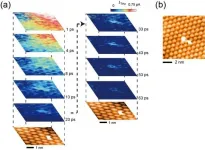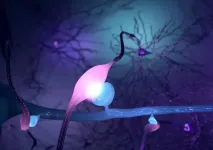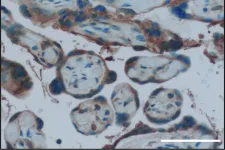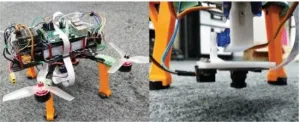INFORMATION:
This research was supported, in part, by NASA.
Written by Jennifer Chu, MIT News Office
Search for axions from nearby star Betelgeuse comes up empty
Results significantly narrow the range of possible places to find the hypothetical dark matter particles.
2021-01-21
(Press-News.org) The elusive axion particle is many times lighter than an electron, with properties that barely make an impression on ordinary matter. As such, the ghost-like particle is a leading contender as a component of dark matter -- a hypothetical, invisible type of matter that is thought to make up 85 percent of the mass in the universe.
Axions have so far evaded detection. Physicists predict that if they do exist, they must be produced within extreme environments, such as the cores of stars at the precipice of a supernova. When these stars spew axions out into the universe, the particles, on encountering any surrounding magnetic fields, should briefly morph into photons and potentially reveal themselves.
Now, MIT physicists have searched for axions in Betelgeuse, a nearby star that is expected to burn out as a supernova soon, at least on astrophysical timescales. Given its imminent demise, Betelgeuse should be a natural factory of axions, constantly churning out the particles as the star burns away.
However, when the team looked for expected signatures of axions, in the form of photons in the X-ray band, their search came up empty. Their results rule out the existence of ultralight axions that can interact with photons over a wide range of energies. The findings set new constraints on the particle's properties that are three times stronger than any previous laboratory-based axion-detecting experiments.
"What our results say is, if you want to look for these really light particles, which we looked for, they're not going to talk very much to photons," says Kerstin Perez, assistant professor of physics at MIT. "We're basically making everyone's lives harder because we're saying, 'you're going to have to think of something else that would give you an axion signal.'"
Perez and her colleagues have published their results today in Physical Review Letters. Her MIT co-authors include lead author Mengjiao Xiao, Brandon Roach, and Melaina Nynka, along with Maurizio Giannotti of Barry University, Oscar Straniero of the Abruzzo Astronomical Observatory, Alessandro Mirizzi of the National Institute for Nuclear Physics in Italy, and Brian Grefenstette of Caltech.
A hunt for coupling
Many of the current experiments that search for axions are designed to look for them as a product of the Primakoff effect, a process that describes a theoretical "coupling" between axions and photons. Axions are not normally thought to interact with photons -- hence their likelihood of being dark matter. However, the Primakoff effect predicts that, when photons are subjected to intense magnetic fields, such as in stellar cores, they could morph into axions. The center of many stars should therefore be natural axion factories.
When a star explodes in a supernova, it should churn the axions out into the universe. If the invisible particles run into a magnetic field, for instance between the star and Earth, they should turn back into photons, presumably with some detectable energy. Scientists are hunting for axions through this process, for instance from our own sun.
"But the sun also has flares and gives off X-rays all the time, and it's hard to understand," says Perez.
She and her colleagues instead looked for axions from Betelgeuse, a star that normally does not emit X-rays. The star is among those nearest to Earth that are expected to explode soon.
"Betelgeuse is at a temperature and lifestage where you don't expect to see X-rays coming out of it, through standard stellar astrophysics," Perez explains. "But if axions do exist, and are coming out, we might see an X-ray signature. So that's why this star is a nice object: If you see X-rays, it's a smoking gun signal that it's got to be axions."
"Data is data"
The researchers looked for X-ray signatures of axions from Betelgeuse, using data taken by NuSTAR, NASA's space-based telescope that focuses high-energy X-rays from astrophysical sources. The team obtained 50 kiloseconds of data from NuSTAR during the time the telescope was trained on Betelgeuse.
The researchers then modeled a range of X-ray emissions that they might see from Betelgeuse if the star was spewing out axions. They considered a range of masses that an axion might be, as well as a range of likelihoods that the axions would "couple" to and reconvert into a photon, depending on the magnetic field strength between the star and Earth.
"Out of all that modeling, you get a range of what your X-ray signal of axions could possibly look like," Perez says.
When they searched for these signals in NuSTAR's data, however, they found nothing above their expected background or outside of any ordinary astrophysical sources of X-rays.
"Betelgeuse is probably in the late stages of evolution and in that case should have a big probability of converting into axions," Xiao says. "But data are data."
Given the range of conditions they considered, the team's null result rules out a large space of possibilities and sets an upper limit that is three times stronger than previous limits, from laboratory-based searches, for what an axion must be. In essence, this means that if axions are ultralight in mass, the team's results show that the particles must be at least three times less likely to couple to photons and emit any detectable X-rays.
"If axions have ultralight masses, we can definitely tell you their coupling has to be very small, otherwise we would have seen it," Perez says.
Ultimately, this means that scientists may have to look to other, less detectable energy bands for axion signals. However, Perez says the search for axions from Betelgeuse is not over.
"What would be exciting would be if we see a supernova, which would ignite a huge amount of axions that wouldn't be in X-rays, but in gamma rays," Perez says. "If a star explodes and we don't see axions, then we'll get really stringent constraints on an axion's coupling to photons. So everyone's crossing their fingers for Betelgeuse to go off."
ELSE PRESS RELEASES FROM THIS DATE:
Electrons caught in the act
2021-01-21
Tsukuba, Japan - A team of researchers from the Faculty of Pure and Applied Sciences at the University of Tsukuba filmed the ultrafast motion of electrons with sub-nanoscale spatial resolution. This work provides a powerful tool for studying the operation of semiconductor devices, which can lead to more efficient electronic devices.
The ability to construct ever smaller and faster smartphones and computer chips depends on the ability of semiconductor manufacturers to understand how the electrons that carry information are affected by defects. However, these motions occur on the scale of trillionths of a second, and they can only be seen with a microscope that can image individual atoms. ...
Study results show COVID-19 virus triggers antibodies from previous coronavirus infections
2021-01-21
The results of a study led by Northern Arizona University and the Translational Genomics Research Institute (TGen), an affiliate of City of Hope, suggest the immune systems of people infected with COVID-19 may rely on antibodies created during infections from earlier coronaviruses to help fight the disease.
COVID-19 isn't humanity's first encounter with a coronavirus, so named because of the corona, or crown-like, protein spikes on their surface. Before SARS-CoV-2 -- the virus that causes COVID-19 -- humans have navigated at least 6 other types of coronaviruses.
The study sought to understand how coronaviruses (CoVs) ignite the human immune system and conduct a deeper ...
Tough childhood damages life prospects
2021-01-21
An adverse upbringing often impairs people's circumstances and health in their adult years, especially for couples who have both had similar experiences. This is shown by a new study, carried out by Uppsala University researchers, in which 818 mothers and their partners filled in a questionnaire one year after having a child together. The study is now published in the scientific journal PLOS ONE.
"When we studied couples where both partners stated they'd had a hard time as children, the connection between negative childhood experience and a relatively ...
Burial practices point to an interconnected early Medieval Europe
2021-01-21
Early Medieval Europe is frequently viewed as a time of cultural stagnation, often given the misnomer of the 'Dark Ages'. However, analysis has revealed new ideas could spread rapidly as communities were interconnected, creating a surprisingly unified culture in Europe.
Dr Emma Brownlee, Department of Archaeology, University of Cambridge, examined how a key change in Western European burial practices spread across the continent faster than previously believed - between the 6th - 8th centuries AD, burying people with regionally specific grave goods was largely abandoned in favour of a more standardised, unfurnished burial.
"Almost everyone from the eighth century onwards ...
When it comes to eyewitness accounts of earthquake shaking, representation matters
2021-01-21
As scientists increasingly rely on eyewitness accounts of earthquake shaking reported through online systems, they should consider whether those accounts are societally and spatially representative for an event, according to a new paper published in Seismological Research Letters.
Socioeconomic factors can play a significant if complex role in limiting who uses systems such as the U.S. Geological Survey's "Did You Feel It?" (DYFI) to report earthquake shaking. In California, for instance, researchers concluded that DYFI appears to gather data across a wide socioeconomic range, albeit with some intriguing differences related to neighborhood income levels during earthquakes such as the ...
Size of connections between nerve cells determines their signaling strength
2021-01-21
The neocortex is the part of the brain that humans use to process sensory impressions, store memories, give instructions to the muscles, and plan for the future. These computational processes are possible because each nerve cell is a highly complex miniature computer that communicates with around 10,000 other neurons. This communication happens via special connections called synapses.
The bigger the synapse, the stronger its signal
Researchers in Kevan Martin's laboratory at the Institute of Neuroinformatics at the University of Zurich (UZH) and ETH Zurich have now shown for the first time that the size of synapses determines the strength of their ...
Investigational combo therapy shows benefit for TP53 mutant MDS and AML patients
2021-01-21
TAMPA, Fla. -- Myelodysplastic Syndromes (MDS) and acute myeloid leukemia (AML) are rare hematologic malignancies of the bone marrow. They can occur spontaneously or secondary to treatment for other cancers, so called therapy related disease, which is frequently associated with a mutation of the tumor suppressor gene TP53. Standard treatment for these patients includes hypomethylating agents such as azacitidine or decitabine but unfortunately outcomes are very poor.
"Patients with TP53-mutant disease, which is roughly 10% to 20% of AML and de novo MDS cases, don't have many options ...
Abandoned cropland should produce biofuels
2021-01-21
Growing perennial grasses on abandoned cropland has the potential to counteract some of the negative impacts of climate change by switching to more biofuels, according to a research group from the Norwegian University of Science and Technology (NTNU).
Researchers consider increased use of biofuels to be an important part of the solution to reduce CO2 emissions. But the production of plants for biofuels can have some unfortunate trade-offs.
Now, the NTNU researchers have come up with a scenario that would put less pressure on food production and plant and animal life.
"We can grow perennial grasses in areas that until recently were used for growing food but that are no longer used for that purpose," explains Jan Sandstad ...
Estrogen receptors in mom's placenta critical during viral infection
2021-01-21
DURHAM, N.C. - Researchers at Duke and Mt. Sinai have identified a molecular mechanism that prevents a viral infection during a mother's pregnancy from harming her unborn baby.
When a person becomes infected by a virus, their immune system sends out a chemical signal called type I interferon, which tells surrounding cells to increase their anti-viral defenses, including making more inflammation.
This response helps to prevent the virus from copying itself and gives the adaptive immune system more time to learn about the new invader and begin to hunt it down.
A pregnant woman ...
Smooth touchdown: novel camera-based system for automated landing of drone on a fixed spot
2021-01-21
Initially earmarked for covert military operations, unmanned aerial vehicles (UAVs) or drones have since gained tremendous popularity, which has broadened the scope of their use. In fact, "remote pilot" drones have been largely replaced by "autonomous" drones for applications in various fields. One such application is their usage in rescue missions following a natural or man-made disaster. However, this often requires the drones to be able to land safely on uneven terrain--which can be very difficult to execute.
"While it is desirable to automate the landing using a depth camera that can gauge terrain unevenness and find suitable landing spots, a framework serving as a useful base needs to be developed first," ...
LAST 30 PRESS RELEASES:
This new understanding of T cell receptors may improve cancer immunotherapies
A new fossil face sheds light on early migrations of ancient human ancestor
A new immunotherapy approach could work for many types of cancer
A new way to diagnose deadly lung infections and save lives
40 percent of MRI signals do not correspond to actual brain activity
How brain-inspired algorithms could drive down AI energy costs
Gum disease may be linked to plaque buildup in arteries, higher risk of major CVD events
Contrails are a major driver of aviation’s climate impact
Structure of dopamine-releasing neurons relates to the type of circuits they form for smell-processing
Reducing social isolation protects the brain in later life
Keeping the heart healthy increases longevity even after cancer
Young adults commonly mix cannabis with nicotine and tobacco
Comprehensive review illuminates tau protein's dual nature in brain health, disease, and emerging psychiatric connections
Book prepares K-12 leaders for the next public health crisis
Storms in the Southern Ocean mitigates global warming
Seals on the move: Research reveals key data for offshore development and international ecology
Sports injuries sustained during your period might be more severe
World's first successful 2 Tbit/s free-space optical communication using small optical terminals mountable on satellites and HAPS
Can intimate relationships affect your heart? New study says ‘yes’
Scalable and healable gradient textiles for multi‑scenario radiative cooling via bicomponent blow spinning
Research shows informed traders never let a good climate crisis go to waste
Intelligent XGBoost framework enhances asphalt pavement skid resistance assessment
Dual-function biomaterials for postoperative osteosarcoma: Tumor suppression and bone regeneration
New framework reveals where transport emissions concentrate in Singapore
NTP-enhanced lattice oxygen activation in Ce-Co catalysts for low-temperature soot combustion
Synergistic interface engineering in Cu-Zn-Ce catalysts for efficient CO2 hydrogenation to methanol
COVID-19 leaves a lasting mark on the human brain
Scientists use ultrasound to soften and treat cancer tumors without damaging healthy tissue
Community swimming program for Black youth boosts skills, sense of belonging, study finds
Specific depressive symptoms in midlife linked to increased dementia risk
[Press-News.org] Search for axions from nearby star Betelgeuse comes up emptyResults significantly narrow the range of possible places to find the hypothetical dark matter particles.




